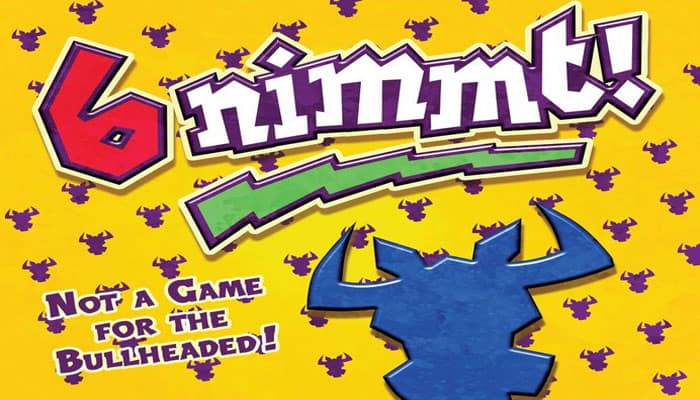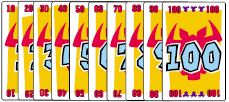

Components
- 104 cards
- 1 rules booklet
Object of the Game
The aim of the game is not to get any cards. Each card you have to pick up will cost you a minus point per bullhead shown on it.
The player who has the fewest bullheads at the end wins the game.
Setup
You will need paper and a pencil for scorekeeping. Shuffle the cards and deal 10 cards to each player. Each player takes his or her cards up in hand and arranges them according to their numbers, in ascending order.

Make Four Rows
Put the top four cards of the remaining pile face-up in the middle of the table. Each of these cards is the first card in a row, in which there may not be more than 5 cards, including this first one.
Put the remaining cards aside; you will not need them until the next round.
Fig. 1 shows the 4 rows at the beginning of the round
Game Play
I. Playing a Card
Each player takes one of the cards from his hand and puts it face-down on the table in front of him. Only after all players have played a card are the cards revealed.
The player whose card shows the lowest number goes first, adding his card to one of the four rows. The player with the second lowest number on his card is next and so on, until all cards played this round have been added to the rows.
Cards are always placed adjacent to each other in a row. The game continues in this manner round by round, until all 10 cards in each player's hand have been played.
Which row is a card added to?
Each card can only be added to one particular row, which is defined by the following rules:
-
Rule No. 1: "ascending Order".
The number of the card that is added to a row must be higher than the number of the current last card in that row.
-
Rule No. 2: "small Difference".
A card must always be added to the row with the smallest possible difference between the current last card and the new one.
Example:

As shown in Fig. 1, the first cards in rows 1 to 4 have the following numbers: 12, 37, 43 and 58.
The four players have played the following cards: 14, 15, 44 and 61. As the lowest card, the "14" is added to a row first.
According to Rule No. 1, it can only be put in the first row, next to the "12". The same rule puts the "15" in the first row, too. Rule No. 1 would allow the "44" to be put in the first, second or third row.
However, Rule No. 2 "Smallest difference" - clearly places it in the third row. According to the same rule, the "61" goes in the fourth row.
Fig. 2 shows the 4 rows after the first round.
II. Getting Cards
Everything is fine as long as you can play your card in one of the four rows. But what happens when a card would go into a row that is full, or when it fits none of the four rows?
In both cases, the player who played such a card gets cards from the table, which score against him.
Rule No. 3: "full Row".
A row with 5 cards in it is full. If Rule No. 2 would put a sixth card in such a row, the player who played that card must take all five cards of the full row. His card then becomes the first in the new row.
Example:

The four players have put down the following cards: 21, 26, 30 and 36.
The "21" and the "26" are added to the first row, which now contains five cards and therefore is full. The "30" must also be added to the first row.
As that would make it the sixth card, the player who put down the "30" must pick up all five cards currently in the row before placing his "30", which is now the first card in the new first row. The "36" then goes in the same row, and is put next to the "30".
Fig. 3: shows the 4 rows after the second round.
Rule 4: "lowest Card".
If a player plays a card whose number is so low that it does not fit into any row, he must pick up all cards of a row of his choice. His card then becomes the first card of the new row.

Example: The following cards have been played: 3, 9, 68 and 93. The "3" is the lowest card and is therefore the first to be added to a row.
As it does not fit into any row, the player must pick up all of the cards in one of the rows. He chooses the second row, picking up the "37", then places his "3" as the first card in the new row.
The player with the "9" has been lucky, because he can now put his card next to the "3".
Fig. 4: shows the 4 rows after the third round.
Note: A player who has to pick up a complete row because the card he wants to play is too low, he will usually choose the row that will score him the fewest minus points.
Bullheads = Minus Points
Between the numbers, each card shows from one to seven bullheads. When a player has to pick up cards, each bullhead represents one minus point.
All cards with numbers:
 containing the figure 5 (5, 15, 25, etc). have 2 bullheads each.
containing the figure 5 (5, 15, 25, etc). have 2 bullheads each.
 that are multiples of ten (10, 20, 30, etc). have 3 bullheads each.
that are multiples of ten (10, 20, 30, etc). have 3 bullheads each.
 that are doublets (11,22, 33, etc). have 5 bullheads each.
that are doublets (11,22, 33, etc). have 5 bullheads each.
 The "55" both is a doublet and contains the figure 5, and therefore has 7 bullheads.
The "55" both is a doublet and contains the figure 5, and therefore has 7 bullheads.
Bullhead Stack
Put all cards you had to pick up on the table in front of yourself, face-down, in the so-called "bullhead stack".
Note: You may not take such cards up in hand for playing.
End of the Game
The game is over when players have played out all ten cards of their hands. Each player then picks up his bullhead stack and counts his minus points.
Take note of each player's minus points on a piece of paper, pick up and shuffle all cards and begin a new game.
The game is played over several rounds, until a player has collected 66 or more bullheads. The player who at this point has the fewest bullheads wins the game.
Of course, you can also decide to play to a different score, or for a set number of rounds.
Continue Reading


